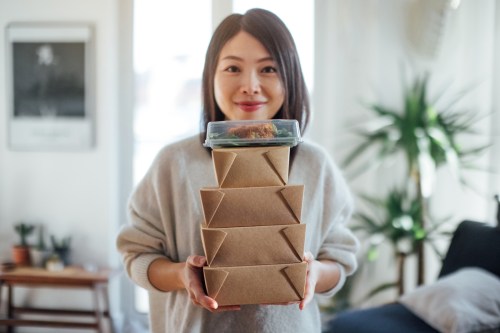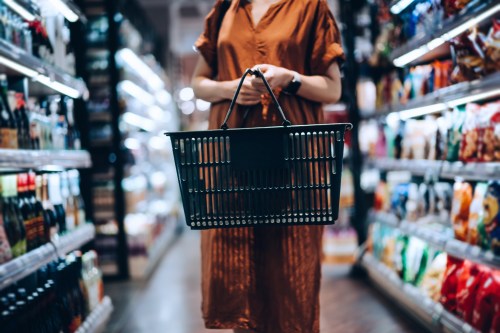I’ve spent the majority of my adult life living several states away from family, only seeing them a few times a year—mostly around the holiday season. During these precious few days at home, I requested all my favorite foods: day-after-Thanksgiving turkey pot pie, cream cheese cookies with jam filling dusted with powdered sugar, Christmas sugar cookies…Somehow, the tradition of it all made them that much tastier.
Experts in This Article
Josh Russ Tupper, the co-owner of the widely loved New York shop Russ & Daughters.
Mandy Sedlak is the food safety and public health manager for EcoLab’s EcoSure division, a global leader in hygiene and infection prevention solutions.
Monique Johnson is the founder of Gertie Kay Sweets, a baked goods company that ships nationwide.
Nothing beats eating your favorite foods with the people you love, but enjoying them from afar can certainly make you feel at least a little closer when you’re unable to be together in person. Biting into a thick slice of warm pumpkin bread slathered with butter always makes me think of the first time my grandmother made it for me—even if I’m not enjoying it at the table with her. Scents and tastes associated with memories are scientifically shown to actually make someone feel happier.
Making and mailing treats to people you care about is always a thoughtful holiday gesture, but the meaning is even greater this year when so many people are spending forced, extended time away from the people they love most due to the pandemic. But it doesn’t mean you can’t share your favorite foods—albeit by mail, or course. Here’s your guide to mailing food safely during COVID-19 to ensure that your loved ones get their holiday goodies in one piece.
Safety tips to keep in mind before you get started
First and foremost, it’s important to make sure the food you’re making is being prepared in a safe way because of COVID-19. Rule number one: If you’re feeling sick in any way, put your cooking and baking for others on hold. “This is actually a common mistake because people put time constraints on getting projects done or think the food preparation cannot wait, but it can,” says Mandy Sedlak, the food safety and public health manager for Ecolab‘s EcoSure division, a global leader in hygiene and infection prevention solutions.
“Wait until you are symptom-free for at least 24 hours before preparing food,” Sedlak adds. Even though there is currently no evidence of food being associated with the transmission of COVID-19, she says it’s still important to take precautions because other viruses and illnesses can be transmitted through food. Feeling good? Sedlak says to wash your hands and to rewash them anytime you are about to work with raw food, and then again before switching to another task.
There are more precautions to consider when packaging and sending food, so we’re not done talking safety just yet. But the next step is knowing what foods can withstand the mailing process—and which foods won’t hold up.
What to make
Monique Johnson, the founder of Gertie Kay Sweets, has turned her side hustle of baking her grandmother’s homemade desserts into an all-out business. She and her mom are busy every day making desserts like sweet potato pies, lemon cake, and dark chocolate brownies, then sending them to people all over the country. Through the process, they’ve definitely learned what types of desserts travel well—and which ones don’t.
The best for shipping, Johnson says, are pound cakes, pies, and brownies because they’re denser and less fragile than other types of desserts—and thus can withstand travel a bit better. “Pies with a more delicate filling, like pecan, are tricker,” she says. Cookies and homemade candies are also safe to ship as well, provided you package them well. (More on that in a minute.) Meanwhile, she says to avoid sending desserts with fresh fruit, since they can go bad in transit unless they’re shipped frozen.
Whatever baked good you make, Johnson recommends wrapping it in plastic and then freezing it until it’s ready to send. “This keeps it fresh and helps lock in the moisture,” she explains.
Looking for something easy and hassle-free to ship? Try these delicious, gluten-free shortbread cookies:
Josh Russ Tupper, the co-owner of the widely loved New York shop Russ & Daughters—which ships nationwide—says there are dos and don’ts in terms of savory foods, too. In addition to prioritizing heartier foods that can stand to be jostled around in the mailing process, Tupper says to think about what still tastes good reheated a day or two later. “I often take leftovers with me to work the next day and the flavors marry in a way that makes the dishes more delicious,” he says. Soups, casseroles, and pot pies are potential examples of this. However, he says anything crispy (like chicken or crispy potatoes) or green salads are not mail-friendly options, since they’ll get soggy and go bad quickly.
But correctly packaging your homemade foods is just as important as knowing what to make, otherwise, all that careful effort of choosing what to send will go to waste.
How to package your food
Packaging. Is. Everything. “Pack everything with the assumption that the delivery guy will pretend he is Jim Carey in Ace Ventura,” Tupper says. “Make it as secure as possible and if it is delicate put it in a tin or in a rigid storage container.” He likes using glass containers and packing them in bubble wrap. Not only does it make the presentation nice, but the person you send the food to can reuse the glass containers when they’re done enjoying the food. “For full cakes and pies, wrap those in plastic and line the container with bubble wrap. Then, tape the container down,” Johnson adds.
Be sure to include ice packs or some other way to keep your package cool as long as possible, says Sedlak. You don’t want to freeze something for it to thaw mid-mailing. “Wrap your ice packs in bubble wrap to prevent it from melting and damaging the cardboard box,” Johnson suggests. Sedlak also recommends the food safety app FoodKeeper, which provides packing tips for specific food items. (There are also some helpful guidelines from the USPS to consider for shipping different kinds of food.)
If you want your food to arrive by a certain time, that’s something else to consider with your packaging and shipping, too. “While you should pack the food to be delivered in two days or less, that’s not exactly realistic right now because USPS is swamped,” Johnson says. “When packing perishables, it’s always good to over-prepare—and maybe overspend. Get first-class mail. Pack it to prepare for a week. Freeze, pack with ice packs, and lots and lots of bubble wrap— that’s the holy trinity.” She also recommends labeling the packages as “fragile” and “perishable.”
Sedlak recommends doing what you can to prevent the food from sitting outside for a prolonged amount of time—especially if the recipient lives somewhere warm. So if you’re sending food to your grandparents in Florida, for example, it’s best to give them a call so they have a heads up to look out for your package. Or better yet, send them the tracking number.
While you definitely have to be mindful and take precautions while sending food, all the experts agree that it’s always a gesture that’s appreciated, now more than ever. “Even sending some of the meal and keeping some of it to share with a loved one over FaceTime or Zoom sounds like a great way to connect and share an experience together.” After all, taste transcends boundaries.
Oh hi! You look like someone who loves free workouts, discounts for cult-fave wellness brands, and exclusive Well+Good content. Sign up for Well+, our online community of wellness insiders, and unlock your rewards instantly.
Sign Up for Our Daily Newsletter
Get all the latest in wellness, trends, food, fitness, beauty, and more delivered right to your inbox.
Got it, you've been added to our email list.











